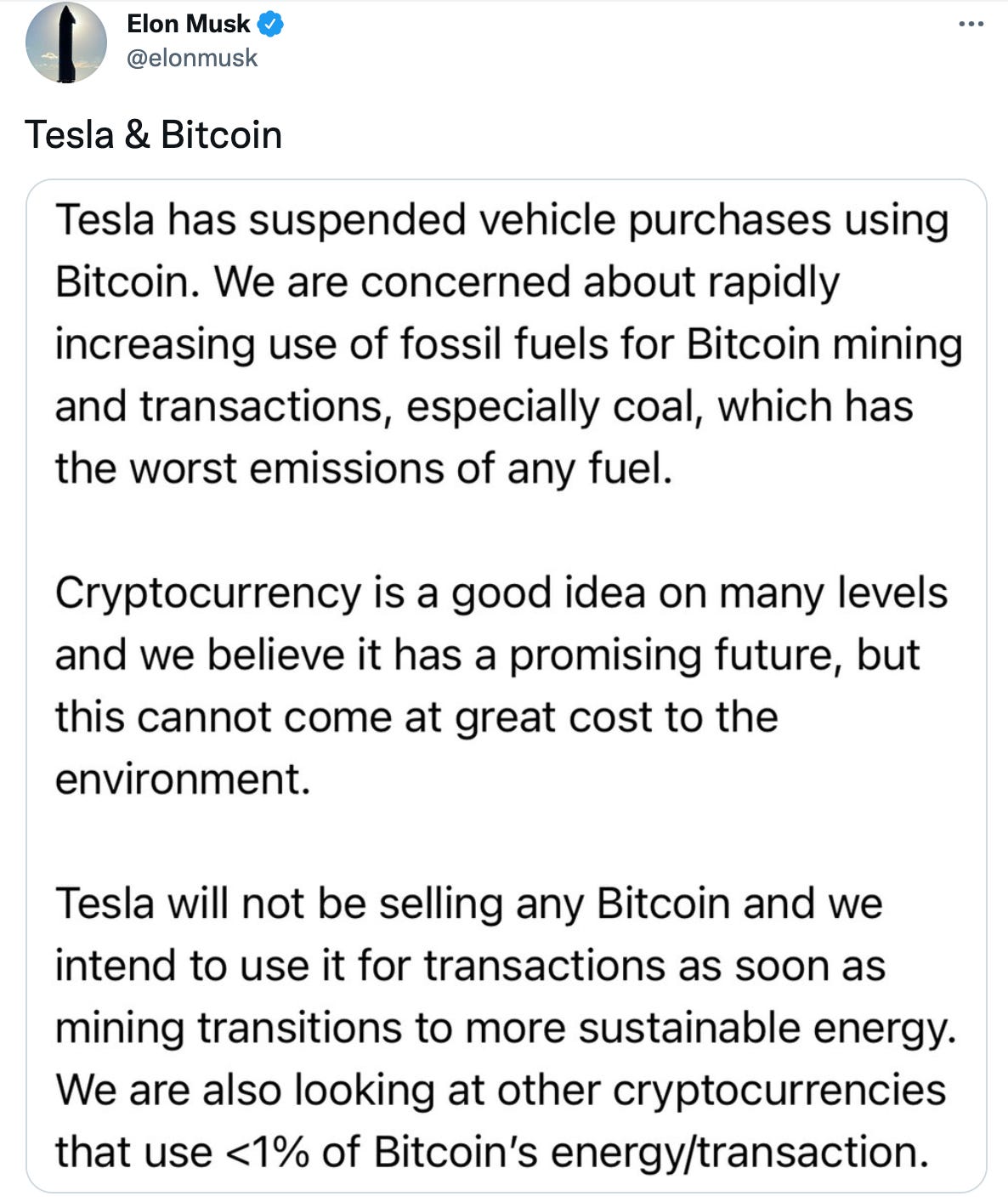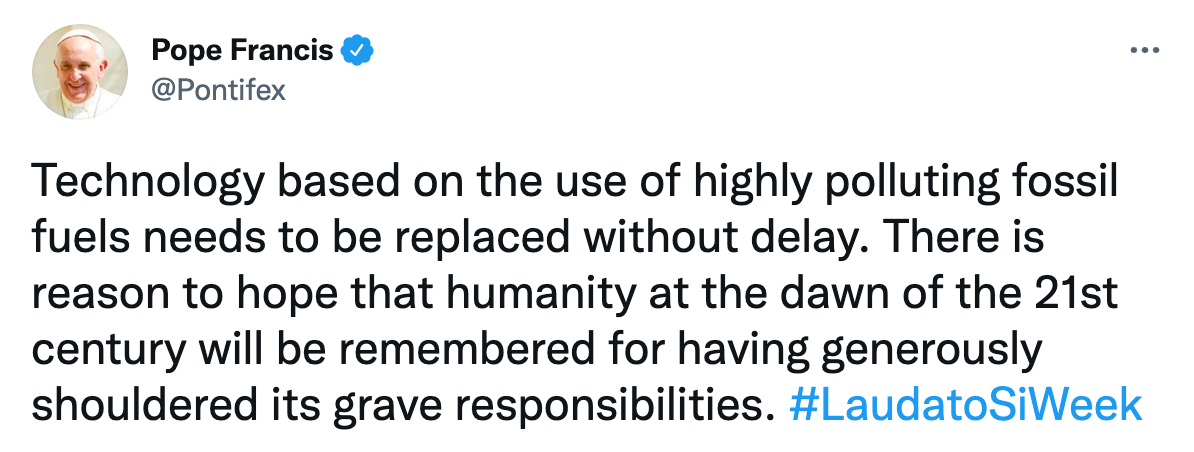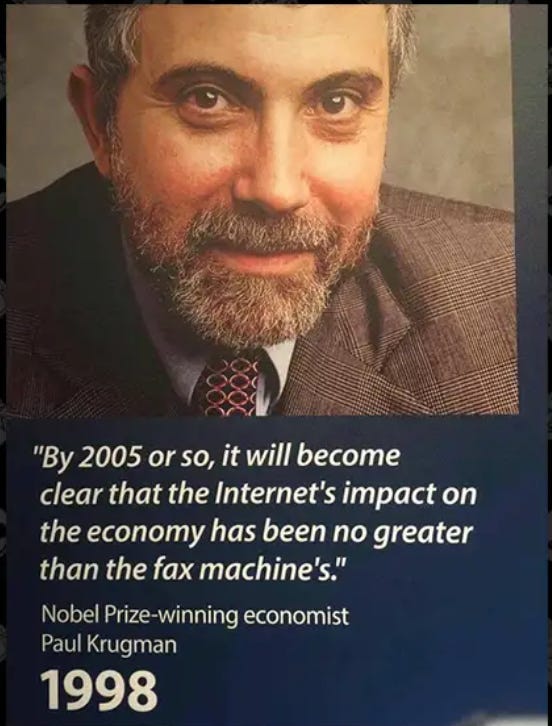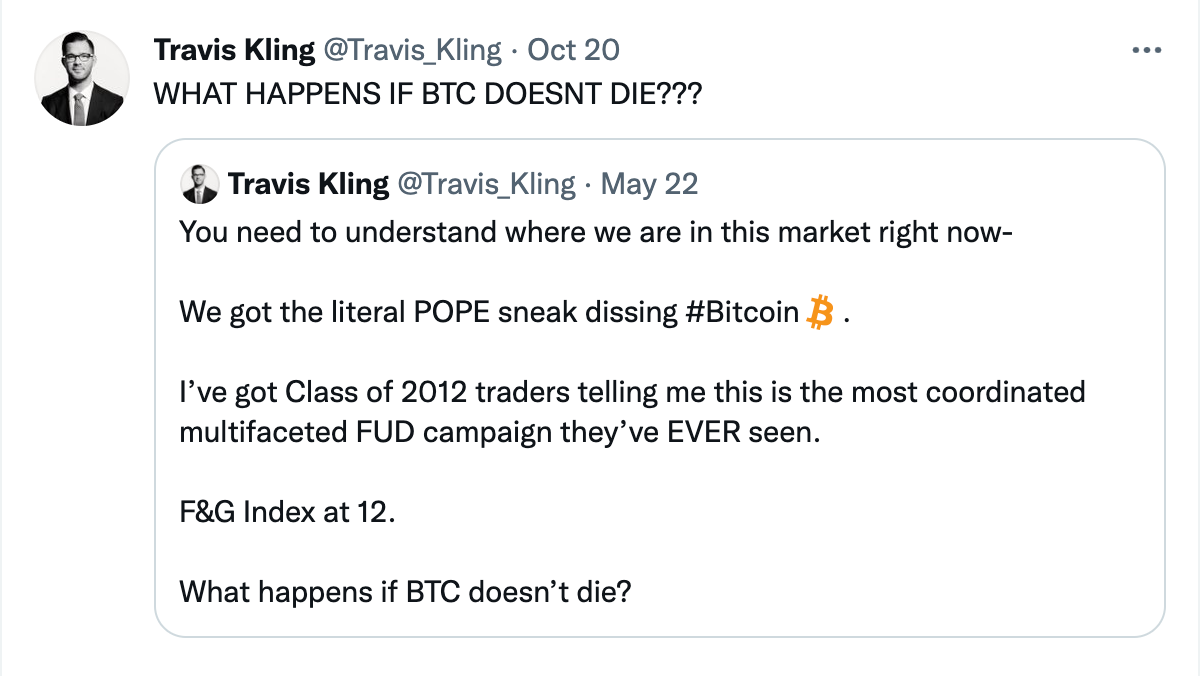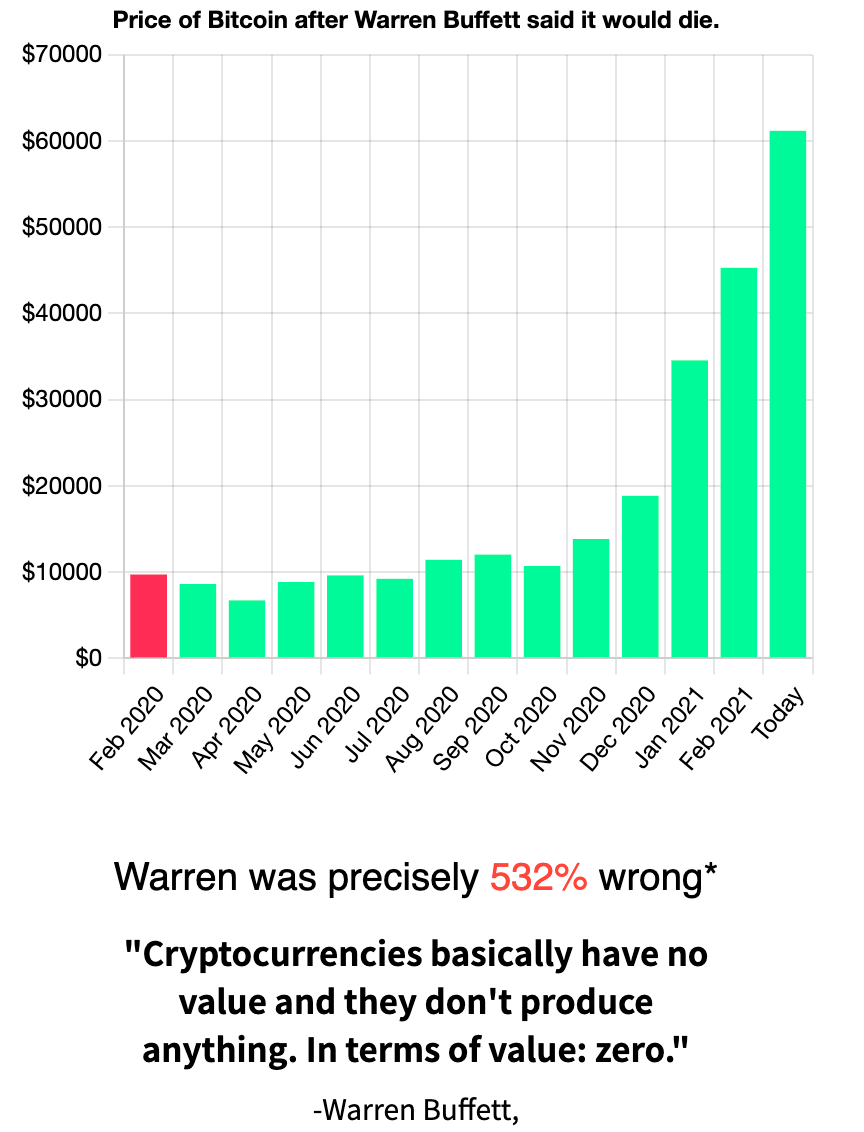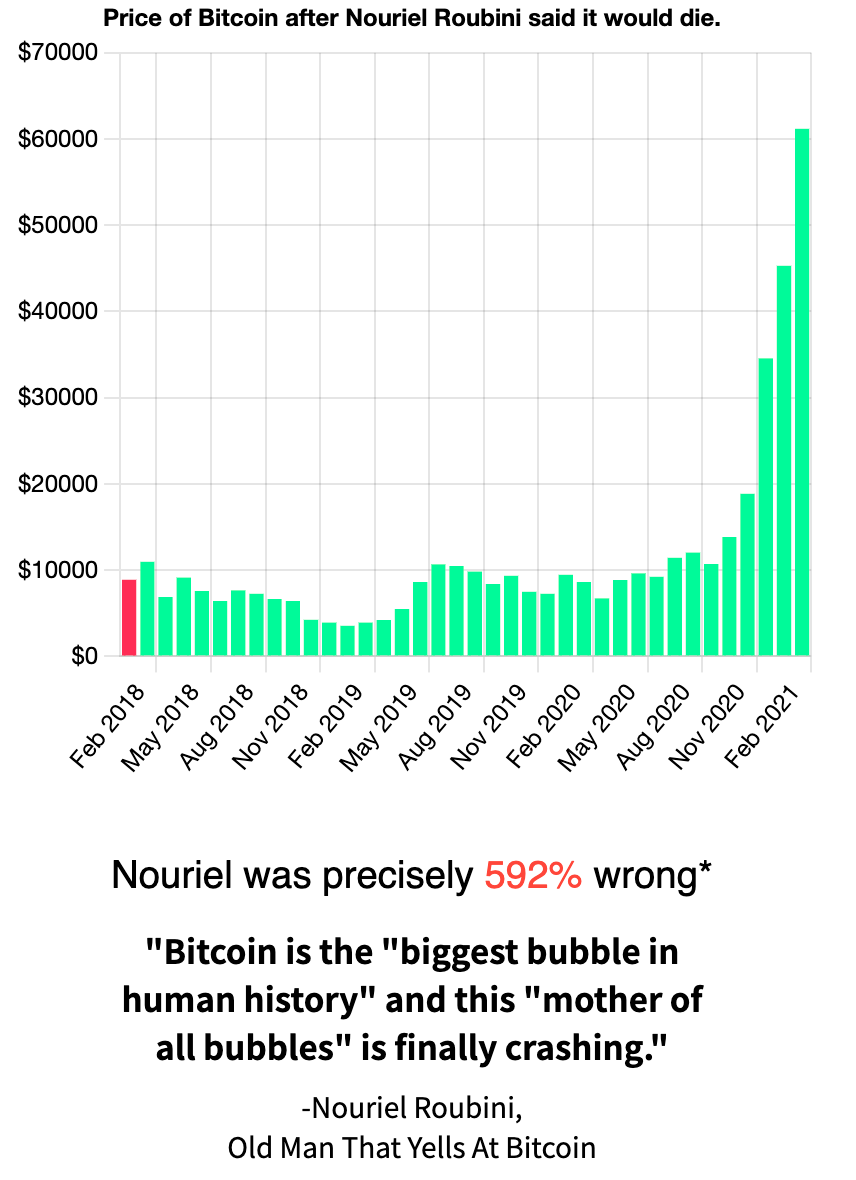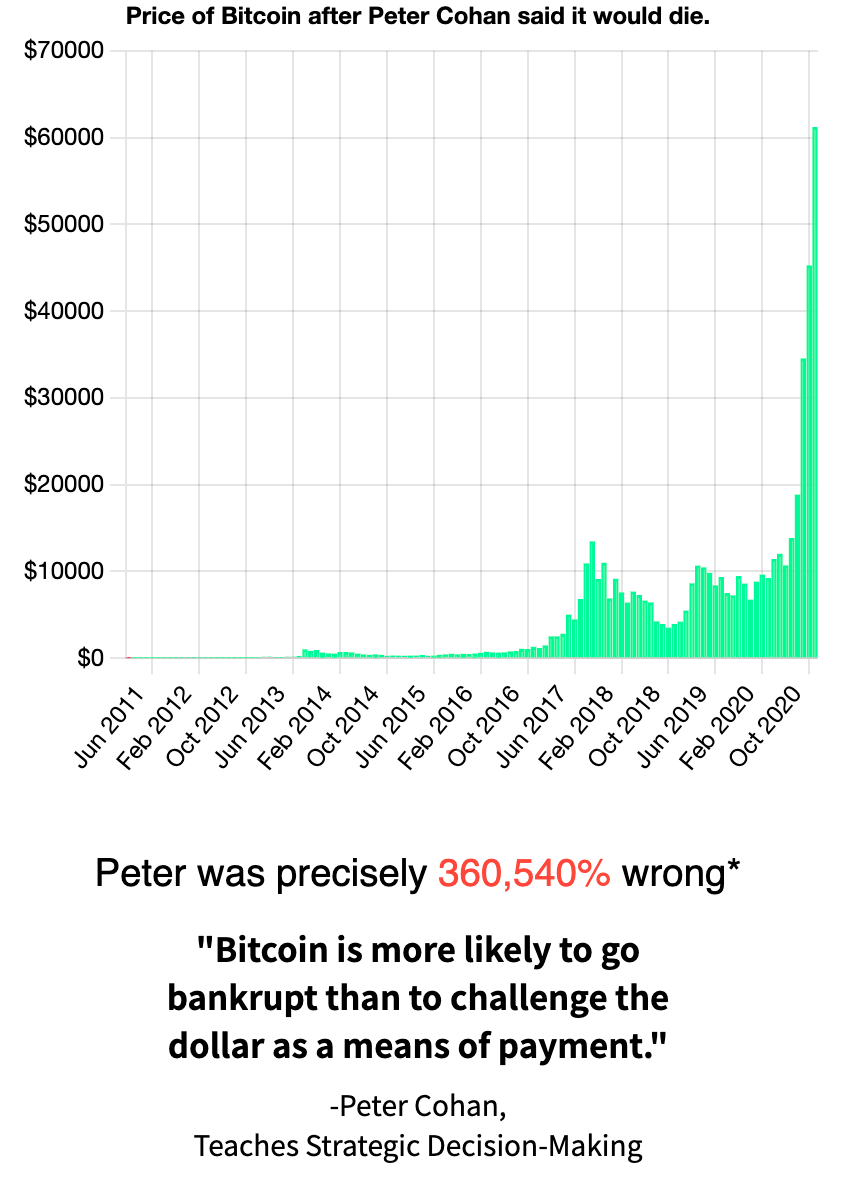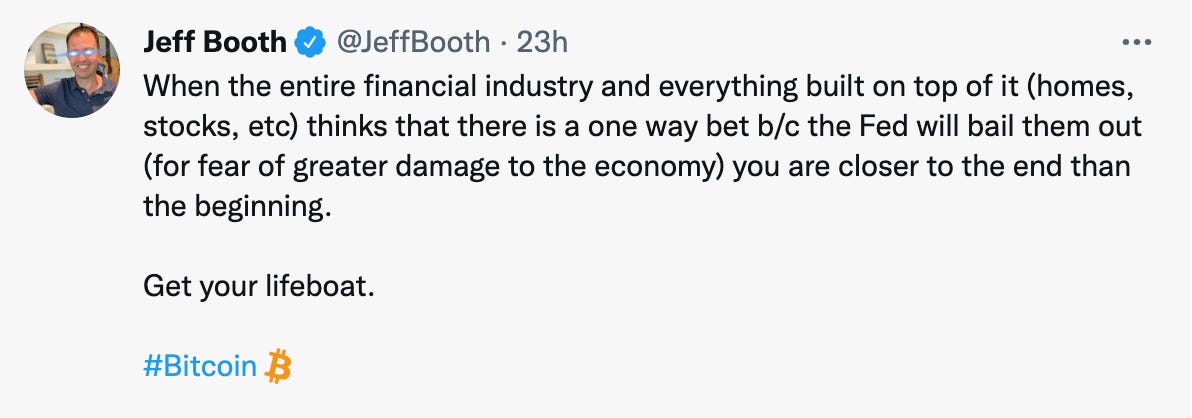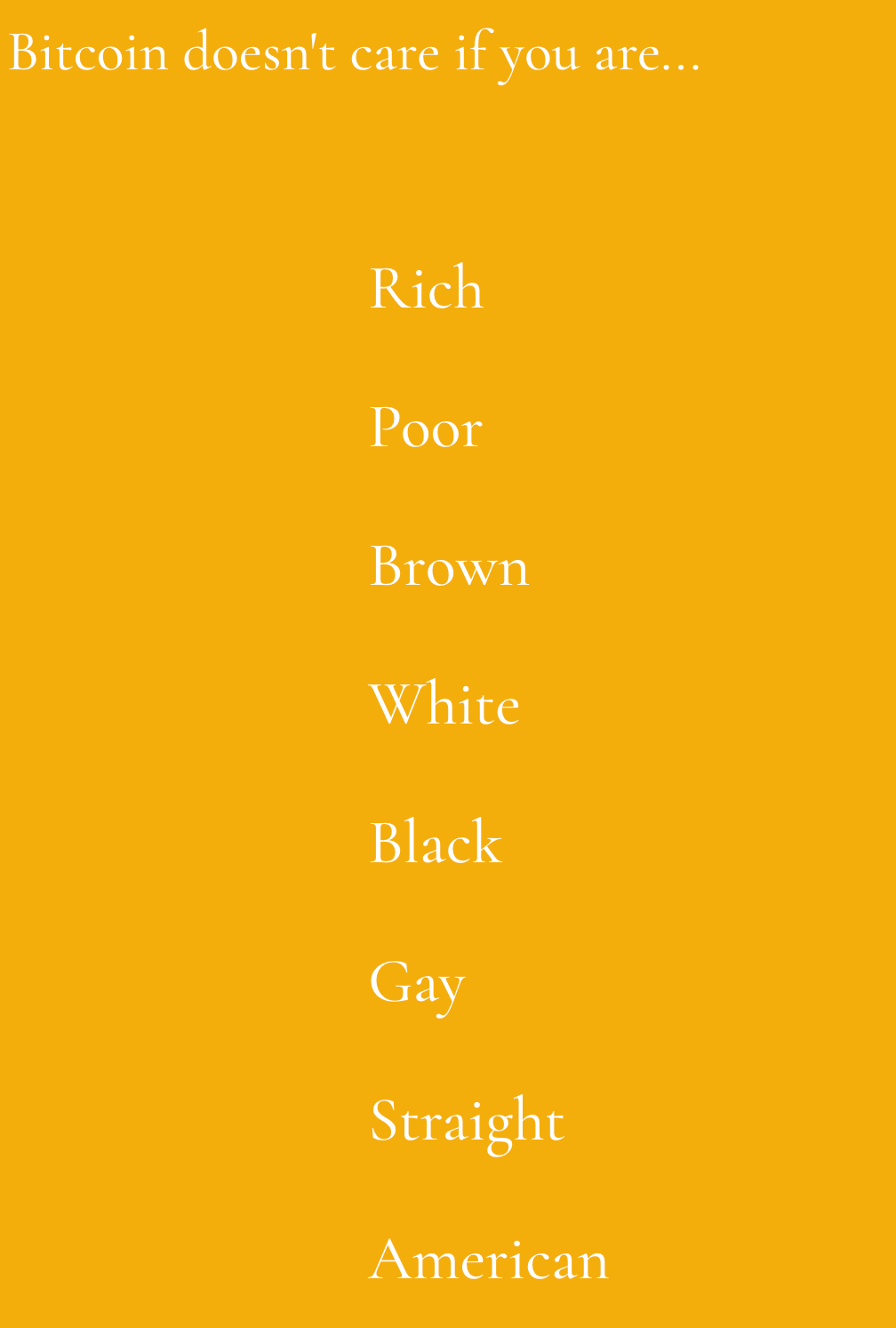Think Bitcoin™ Issue #11
Significance of new all-time highs; macro case for Bitcoin; Bitcoin as true impact investing
Hey friends, welcome back to Think Bitcoin™. It was obviously an exciting week in the world of Bitcoin and, as per usual, there’s a lot to discuss. As always, if you have any questions or comments, feel free to reach out!
In this issue:
Headlines/Insights: The significance of new all-time highs; first U.S. public pension fund buys bitcoin
Content Round-Up: 3 articles, 2 podcasts
As always, if you find this newsletter interesting or useful, please share it with others who might find it interesting or useful!
Headlines and Insights
The significance of new all-time highs
I’ve intentionally refrained from writing about the price of bitcoin since the inception of this newsletter. You have not and will not see me making price predictions, deeply analyzing price action, or parsing on-chain data. This isn’t because I think price is unimportant or irrelevant. It’s just because my aim here is to help you understand how Bitcoin works at a more fundamental level, the problems it seeks to solve, and the ways in which it can reshape (and improve) the world. In other words, my goal is to play a role in your Bitcoin education journey. What you do with that education is ultimately up to you.
All that being said, this past week we reached new all-time highs in the price of bitcoin, and I am going to talk about it.
Why? Because I think this milestone is significant for three important reasons that have broader implications:
The Lindy Effect
People who see Bitcoin recover from a 50+ percent drop tend to stay
Strength of the macro narrative
First, the Lindy Effect. The Lindy Effect was first described in an article written in The New Republic by Albert Goldman in 1964. Author Nassim Nicholas Taleb discussed the idea in his widely read book, Antifragile: Things That Gain from Disorder. The Lindy Effect is the simple proposition that the longer a non-perishable thing (so not an apple or a horse or a human) survives, the longer it can be expected to survive.
With respect to Bitcoin, the Lindy Effect strengthens every time the network survives a significant bout of adversity, whether in the form of a deep drawdown in price or a withering (some would argue, coordinated) campaign of negative commentary from traditional financial media, politicians, regulators, and nation-states.
[As a quick point of vocabulary for anyone new to the space, one of the many neologisms in the Bitcoin world is “FUD,” which is an acronym for “Fear, Uncertainty, and Doubt” and refers to these types of withering campaigns of negative commentary].
Over the course of this year, the FUD was deafening and ubiquitous. For starters, we’ve had a relentless barrage of criticism, almost uniformly misinformed, relating to Bitcoin’s environmental impact, much of which has been published in such prominent places as the Wall Street Journal, the New York Times, and CNBC. This criticism has been parroted by politicians like Elizabeth Warren, as well. As I’ve discussed in this newsletter on many occasions, the Bitcoin community has responded vigorously to this flavor of condemnation and gone on the educational offensive about bitcoin mining, how much energy it uses, the sources of this energy, and the purpose of the energy use.
For those who may have missed some of the previous issues directly addressing environmental criticism, check out Lyn Alden’s “Bitcoin’s Energy Use Isn’t a Problem. Here’s Why.” See also, “The Frustrating, Maddening, All-Consuming Bitcoin Energy Debate,” an article by Nic Carter, who has taken it upon himself to respond, point-by-point in many cases, to nearly every Bitcoin energy polemic published in mainstream financial media outlets. For those who prefer the visual to the written word, check out the great documentary, This Machine Greens. There’s also the Bitcoin Mining Council, which publishes reports on how renewable bitcoin mining’s energy sources are, particularly as compared to other industries. Or you could read “Bitcoin is Key to an Abundant, Clean Energy Future,” a memo co-written by Jack Dorsey’s Square and Cathie Wood’s ARK Invest. You get the idea.
But who can forget Elon Musk’s molotov cocktail of environmental FUD in May:
Elon has since walked this back significantly and subsequently acknowledged that he, personally, Tesla, and SpaceX, each own bitcoin (a classic example of watch-what-they-do-not-what-they-say). At the time of this infamous tweet, it seemed obvious (to me, at least, and many others) that Elon was tapped on the shoulder by someone at BlackRock or perhaps a major shareholder, folks who financially rely on Tesla maintaining its ESG designation, and told to pipe down the Bitcoin promotion. Remember also that much of Tesla’s business involves selling regulatory credits. This was a time of nearly pervasive environmental FUD, and Elon was likely told that Tesla could not appear to be endorsing a technology that the New York Times said was wasteful, even if the New York Times verifiably did not (and still does not) understand Bitcoin. Even Pope Francis chimed in, in what many viewed as a veiled reference to Bitcoin:
Pope Francis prompted this reply from one Twitter user, which, grammatical errors notwithstanding, I think was incisive:
In addition to the environmental FUD, there was China banishing bitcoin miners and then, a few months later, attempting to ban Bitcoin altogether. For a long time, Bitcoin critics pointed to the relative concentration of miners in China as a potential vulnerability or red flag. The omnipresent prospect of China banning Bitcoin was seen by those critics as the guillotine blade hanging over the network’s metaphorical head, the release of which was inevitable and the result of which, these critics posited, was sure to be fatal. Alas, China did eventually ban Bitcoin but, far from fatal, this merely revealed the misunderstandings underpinning the concern in the first place. The critics failed to grasp Bitcoin’s statelessness and resilience as a network, its mobility, and, most importantly, its anti-fragility. After China banished bitcoin miners, the network’s hash power initially dropped sharply as those mining rigs went offline. However, over time, those rigs and miners relocated to other parts of the world, many to the U.S., in fact. And slowly but surely, hash power recovered.
Similarly, when China said it would ban all crypto use in September, the price of bitcoin initially dropped. Surely, critics thought, this was the end for Bitcoin. But the price recovered. Critics again underestimated the global user-base and under-appreciated the self-sovereign ways in which users can hold, move, and relocate with their money.
On top of misguided environmental angst and China’s ban, we’ve also seen a regulatory backlash as SEC Chair Gary Gensler, encouraged by folks like Senator Warren and Treasury Secretary Janet Yellen, has made it his stated aim to jam the square peg of crypto into the round hole of existing (and ancient) securities law frameworks. Senator Warren has referred to bitcoin as just as a network of “shadowy super coders” solving “useless math problems.” Clearly she hasn’t studied bitcoin’s use in Nigeria (see also this article), Sudan, Ethiopia, the Gaza Strip, Cuba, Afghanistan, El Salvador, South America, Zimbabwe, and so many other places. She also clearly doesn’t know that about 44% of people who own crypto are persons of color, and 41% are women. I doubt she’s read Bitcoin and Black America. Instead, Senator Warren, a longtime (and commendably so) critic of big banks and exploitative financial intermediaries has bizarrely directed her ire towards the biggest threat to exploitative financial intermediaries that has ever existed. This reveals more about her than it does about Bitcoin. She and Bitcoin take aim at the same problem. Bitcoin just doesn’t need to rely on politicians and institutions, each of whom have bad incentives baked into their operation, to accomplish the desired end.
While SEC Chair Gensler makes television appearance after television appearance and congressional appearance after congressional appearance reiterating his intention to regulate stablecoins, DeFI, and crypto exchanges, he has also repeatedly praised Bitcoin’s pseudonymous creator, Satoshi Nakamoto, and the innovation Bitcoin represents. And now the SEC has even approved a Bitcoin futures ETF.
Then there were the boomer economists, those Keynesian architects of our current system. Nobel Prize winner Paul Krugman wrote, “Twelve years on, cryptocurrencies play almost no role in normal economic activity” and called them a Ponzi scheme. While the crypto space as a whole has more than its fair share of scams, rug pulls, and Ponzi schemes, Bitcoin does not fall into this category. And the market knows it. This type of criticism should also be taken with a metric ton of salt, seeing as it comes from the same genius who thought the internet was about as useful as the fax machine.
Then there’s Charlie Munger, the 97-year-old billionaire and Vice Chairman of Berkshire Hathaway, who is also a noted fan of China’s authoritarian handling of their economy. He called Bitcoin “disgusting and contrary to the interests of civilization.”
In sum, as I think is obvious, the last six to ten months has been a non-stop, torrential downpour of FUD in various forms. But Bitcoin is still here. Not only is it still here; it’s also reaching new all-time highs. If the last six months can’t kill Bitcoin, can anything kill Bitcoin?
Enter the Lindy Effect. Bitcoin has survived more “deaths” than anyone or anything. I encourage everyone to check out bitcoinisdead.lol for a colorful (and NSFW) presentation of just how many folks have been wrong about Bitcoin. Some examples:
The longer Bitcoin survives, the stronger its network effects get, the more certain it is to continue surviving. This is the Lindy Effect, and it’s stronger than ever. Newer folks to Bitcoin tend to mistake its youth as an asset for fragility. I’ve had countless interactions in which people tell me that once Bitcoin has proven to have the durability of, say, an S&P index fund or Microsoft stock, they will invest some money in it. Ironically, these are the same folks who tend to have an allocation to negative real-yielding bonds and entirely fail to understand the absolutely dire future for U.S. Treasuries, something folks like Ray Dalio have spoken about frequently. To these folks I would simply say institutions (and even nations) have tried to kill Bitcoin for 10 years, and it’s still here. There’s a reason it’s still here, and you should take some time to learn about it.
Moving on to reason number two that I think this past week’s price milestone is important. People who witness one of these resurrections, so to speak, one of these comebacks that Bitcoin pulls off every cycle, tend to stay. In other words, Bitcoin’s survivability compels many initially skeptical or casual users/observers to spend some time learning about it to discover why and how Bitcoin didn’t die. This leads to the proverbial journey down the proverbial rabbit hole, and the network is consequently strengthened for the next cycle, as more folks embark on said journey.
Third, this new all-time high continues to reflect the macroeconomic circumstances we find ourselves in, circumstances to which a rapidly increasing number of investors, citizens, and politicians are waking up. Inflation is here, and not just in assets anymore. The national debt is growing at a pace that shows no signs of meaningfully slowing for any sustained period in the future. The historic increase in the money supply the Fed has undertaken since March of 2020 is likely, by necessity, to keep going.
As Luke Gromen has pointed out on numerous occasions, the government’s interest payments plus entitlement obligations now exceed 100% of tax receipts. To compound matters, as Gromen notes, we are a twin-deficit country with a deeply negative net international investment position. We seem very much to have arrived at the part of the story in which the government has almost no choice but to inflate the debt away. This means hard, uninflate-able assets become increasingly important. It also means that fiat currencies will become increasingly debased.
Last week, Peter Thiel described Bitcoin as the “canary in the coal mine.” He noted further that, "it's the most honest market we have in the country, and it's telling us that this decrepit … regime is just about to blow up."
On Friday night, Jack Dorsey tweeted the following:
Legendary investor (and bitcoin holder) Paul Tudor Jones went on TV last week and said inflation is decidedly not transitory. Even JPMorgan has acknowledged that inflation is here.
The wheels are starting to come off a little bit. To borrow from Yeats, the center seems like it may not be holding, after all. In this environment, Bitcoin is a lifeboat. And the market is catching on.
The Houston Firefighters' Relief and Retirement Fund buys bitcoin
Speaking of milestones, this is a first. The Houston Firefighters’ Relief and Retirement Fund announced last week that it purchased bitcoin for its defined benefit plan's portfolio. It is the first public pension fund in the United States to do so. This would appear to be a clear harbinger of things to come, as there are a lot of pension funds holding a lot of negative or low-yielding bonds. Exciting times.
Content Round-Up
1. “Inside the World of Black Bitcoin, Where Crypto Is About Making More Than Just Money,” an article in Time Magazine by Janell Ross. This piece chronicles the author’s coverage of the Black Blockchain Summit, which was held in September of this year. Ross spoke to several prominent Black bitcoiners about the history of financial oppression in this country, the opportunities that Bitcoin offers for transcending the historically exclusionary system of traditional finance, and the challenges that remain. Among those mentioned in or interviewed for the piece are Sinclair Skinner, Najah Roberts, Hill Harper, Charlene Fadirepo, Cleve Mesidor, and Isaiah Jackson, all of whom you should follow.
2. “Bitcoin and the U.S. Fiscal Reckoning,” an article in National Affairs by Avik Roy. This is one of the best summations of the macroeconomic case for Bitcoin I’ve encountered. Roy discusses the inevitable and sobering choice the United States will eventually have to make as it continues to expand the money supply and the federal debt. In Roy’s words:
“In time, policymakers will face a Solomonic choice: either protect Americans from inflation, or protect the government's ability to engage in deficit spending. It will become impossible to do both. Over time, this compounding problem will escalate the importance of Bitcoin.”
If you’ve read this newsletter for a while, you know that I think there are a couple of different fundamental ways of approaching Bitcoin and understanding its value to the world. One is obviously understanding the technology and how the technology itself solves certain problems. Another, though, is the macroeconomic case for Bitcoin, meaning how does Bitcoin fit into, challenge, and address the current debt-fueled paradigm of global economics. This article does a great job of summarizing this macroeconomic case.
To anybody who doesn’t spend much meaningful time thinking about the national debt or why it matters, I urge you to spend some time with this article. It succinctly chronicles how we arrived at our current fiat money system, the declining health of that system, and what comes next.
Bonus: If you want to listen to Avik Roy discuss this piece on a podcast, check out his appearance on the What Bitcoin Did Podcast. The first 30 minutes or so is about healthcare and can be skipped if you want to get right to the main discussion.
3. “Is Bitcoin a Game-Changer for Social Impact Investing?” This article, written by Christopher Bendiksen in collaboration with Alex Gladstein, makes the case that investing in Bitcoin is the best social impact investment one can make. More and more, investors and investment committees are focused on the ESG (Environmental, Social and Governance) impact and implications of their investments. The “E” (Environmental) tends to get a disproportionate amount of attention to the exclusion of social and governance concerns. It’s possible that this is simply because it’s easier to measure, or at least formulate metrics for measuring, the environmental impact of a company than it is to measure the social impact of an investment. The existing frameworks for measuring social impact are sorely lacking.
For example, as Alex Gladstein points out, “There are about 10,000 words that make up the SDGs (the sustainable development goals released by the United Nations) and some terms do not appear a single time: democracy; civil liberties; free and fair elections; press freedom; free expression; journalism; independent judiciary; or separation of powers. Corruption and freedom get one mention each; human rights gets four mentions.”
This article makes the case that if you truly believe in global human rights, equal access to financial services, freedom from censorship, and freedom from inflationary currencies, Bitcoin is far more socially impactful than any other investment you can make.
As Gladstein notes, and as we often forget or don’t think about, “only 13% of humans live in a liberal democracy with a reserve currency. That means 87% of the world's population either lives under a weaker currency or an authoritarian regime.”
I know so many folks, and see so many more online, who are justifiably fixated on ESG concerns. If you are one of these people and you are looking for the most impactful way to invest your money, I urge you to educate yourself on Bitcoin and how it promotes global human rights.
One last long quote from the article:
In Gladstein’s words: “At the end of the day, all the other impact investing efforts we make are negotiations with human rights abusers.” Bitcoin changes that. An investment in Bitcoin deepens its network effect, improves its ability to function as a monetary alternative for those who need it the most, and directly contributes to improving their situation on the ground, no matter what their ruling elites may think about it.
Bitcoin exists entirely outside the control of any regime. An authoritarian government cannot restrict the use of Bitcoin any more than they can restrict file sharing or illegal streaming of football games—it is just not realistically feasible to prevent motivated people from using apps on the Internet.
Practically for the first time then, investors are presented with an investment that offers a real possibility to positively impact billions of people living under authoritarian oppression. Bitcoin does this in an entirely automated fashion through native enforcement of property rights, built-in privacy, an inability to discriminate based on gender, race, religion or any other characteristic, and its ability to offer full monetary sovereignty for end users, regardless of where they happened to be born. And it does it without the need for anyone’s permission.”
4. Roya Mahboob on an episode of the Coin Stories Podcast with Natalie Brunell. Mahboob was one of the first female tech CEOs in Afghanistan. In 2013 she actually began paying her female employees in bitcoin, which allowed them to hold and protect their money without the men in their lives knowing about it or being able to confiscate it. Her story is chronicled in the great article, “Finding Financial Freedom in Afghanistan,” by Alex Gladstein, which I also recommend checking out.
5. Matthew Diemer and Ian Calderon on the Swan Signal Podcast. Matthew Diemer is a Democrat running for office in Ohio’s 16th Congressional District. Ian Calderon is a Democrat and former California State Assembly member. They each discuss their perspectives on Bitcoin and how they think governments should look at Bitcoin.
Bonus/Miscellaneous
As I’ve said before, Bitcoin transcends the ossified two-party political framework we’ve grown accustomed to in the U.S. It offers an opportunity to reshape the world and address systemic flaws in ways that partisan politics cannot. Bitcoin belongs neither to Republicans nor Democrats, and folks from myriad and divergent political backgrounds recognize its promise and value. In this issue alone I’ve linked to resources from folks with widely different political affiliations, each of whom is drawn to Bitcoin.
However, it does appear to me that, notable exceptions notwithstanding, it’s the progressives in Congress who seem to struggle most with Bitcoin. Ironically, Bitcoin seeks to advance many ideas that progressives have championed and prioritized for years, things like financial access, economic rights, addressing the wealth gap, ending economic discrimination, eradicating rent-seeking financial intermediaries, addressing climate change, etc. In fact, Bitcoin accomplishes nearly all of these aims better and more efficiently than the polarized, senescent legislative body we call the United States Congress.
This is why I think it’s especially important to educate progressives about Bitcoin. With that in mind, here’s a great compilation of resources to that end at theprogressivebitcoiner.com.
As always, thanks for reading! If you enjoyed it or found it useful, share this newsletter widely and freely!
“Civilization is in a race between education and catastrophe. Let us learn the truth and spread it as far and wide as our circumstances allow. For the truth is the greatest weapon we have.” -H.G. Wells
See you next week,
Logan
SOCIAL
DISCLAIMER: I am not investment advisor and this is not investment advice. This is not, nor is it intended to be, a recommendation to buy or sell any security or digital asset. This newsletter exists for educational and informational purposes. Do your own research before making any investment decisions.
© Copyright The Why of FI.




